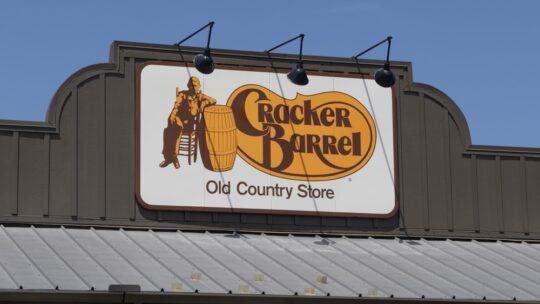
This week’s roundup looks at Cracker Barrel’s controversial logo relaunch, Taylor Swift and Travis Kelce’s engagement, and the brewing backlash against J.Crew for using AI in creative.
Cracker Barrel Unveils New Logo, Backtracks Amid Major Backlash
What happened: There aren’t many logo relaunches that get the attention of the president of the United States, least of all inspire commentary and branding advice for the future.
But Crackle Barrel’s logo redesign, announced in a press release on Aug. 19, managed to drum up backlash bordering on mania, a frenzy of expert commentary about what went wrong—and a weigh-in from POTUS himself.
For the uninitiated few, the revision removed the following from the logo: an overalled older gentleman known as “Uncle Herschel,” the barrel he was leaning against, and the phrase “Old Country Store" beneath it.
The revamp of the iconic restaurant chain, which included updated menu items and a refresh of the 660 stores’ antique-clad dark interiors, was an attempt at modernizing the brand to attract new customers. But the fallout from the change was massive, sparking ire from longtime customers who threatened to boycott the chain unless it scrapped the changes. The detrimental effects were financial as well, with shares dropping more than 10% after the logo was introduced.
Following the initial uproar, Cracker Barrel held steady with its rebrand and on Aug. 25 released a statement on its website assuring consumers that they did not intend to backtrack. “If the last few days have shown us anything, it’s how deeply people care about Cracker Barrel. We’re truly grateful for your heartfelt voices,” the company said. “You’ve also shown us that we could have done a better job sharing who we are and who we’ll always be.”
But after a subsequent social media post—followed by an actual phone call—from President Trump, which urged the brand to “go back to the old logo, admit a mistake based on customer response (the ultimate Poll) and manage the company better than ever before,” the company did an about face, abandoned the changes and reinstated its former iconography.
“We thank our guests for sharing your voices and love for Cracker Barrel. We said we would listen, and we have. Our new logo is going away and our “Old Timer” will remain,” the company said. Shares climbed 8% the next day following the news.
View this post on Instagram
Communication takeaways: Plenty has been written about Cracker Barrel’s much-maligned communications approach—far too much to recount here. But many experts agree that the rebrand failed to consider existing customers’ deep emotional attachment to the brand’s nostalgic core.
“The transformation failed to take into consideration the emotional equities they own, delivered through their restaurant experience,” said Jean-Pierre Lacroix, President of global CPG branding firm Shikatani Lacroix Design. “The hopes of attracting newer and younger consumers come at a cost of alienating their existing, loyal customers. The new logo and experience, albeit more contemporary, does not support the nostalgic dimension of the brand, creating a large disconnect,” he wrote on LinkedIn.
Lacroix believes that consumer research conducted by the brand is likely the culprit. “It seems they were using conventional research metrics to evaluate the likability of the brand, but they didn’t research the emotional equity Cracker Barrel owns and needs to be maintained. I would stop renovating and revisit what entities they need to protect,” he wrote.
PR and crisis management expert Edward Segal, author of the book “The Crisis Casebook: Lessons in Crisis Management from the World’s Leading Brands,” took issue with the announcement itself.
“Cracker Barrel’s decision to bury the mention of the rollout of the new logo in a press release about its new fall menu shows that the company had a flawed and counterproductive communication strategy,” he said. “Instead of burying the announcement of the new logo, Cracker Barrel should have highlighted and promoted it aggressively.”
To prevent such a crisis, Segal advises “doing research on the impact that changes to the image they project will have on target audiences; explaining their reasons and justifications for making the changes; and introducing those changes in such a way so as not to create a PR or political firestorm.”
Lacroix believes that while abandoning a barrel and an Old Timer, it discarded the “foundational principles of emotional branding” along with it.
“The lesson here is simple but profound: transformation works only when it honors history, values community, and inspires us to feel something real,” he said. “Otherwise, even the best intentions can lead to an identity crisis, not a resurgence."
A Co-branded Powerhouse: Taylor Swift and Travis Kelce
What happened: The news about America’s sweethearts just keeps on coming: Pop music icon Taylor Swift and Kansas City Chiefs tight end Travel Kelce are officially engaged. The celebrity couple broke the news on Tuesday through an Instagram post featuring the lovebirds embracing amid an elaborate floral garden with the caption, “Your English teacher and your gym teacher are getting married 🧨”—a nod to the way Swifties' have referred to the couple in the past. The post had racked up nearly 35 million likes at press time. Celebrities, British royalty and President Trump were among those who congratulated the couple publicly.
True to form, Swift’s rollout of the news was planned and purposeful. Just 13 days prior to the announcement—important timing, as Swift’s lucky number is 13—the pop star made a surprise appearance on Kelce’s “New Heights” podcast with brother/co-host Jason Kelce to announce the forthcoming release of her 12th studio album, “The Life of a Showgirl.” And as we wrote about last week, scores of brands hopped on the bandwagon with TS12-themed activations, from McLaren to Google to the Empire State Building.
View this post on Instagram
Communication takeaways: We’ve often written about Swift’s masterful marketing machine, highlighting her team’s ability to control the narrative, leverage authenticity, and surprise and delight her rabid fanbase. This next step in her life and career is no different. The union of these two superstars will further cement the power couple’s cultural relevance and boost the personal and professional brands embodied by each.
For communicators, there are several lessons to glean from the couple’s reveal. “Swift and Kelce are major brand names in their respective industries, and their romance provides marketing and communications professionals with a premium case study in cross-industry branding,” wrote Nicole Tidei, Vice President at Pinkston, in a PRNEWS column this week.
“With their engagement, Swift and Kelce are no longer just individual powerhouses building influence in separate lanes. They’re a merged brand ecosystem with unparalleled reach,” Tidei said. Their union reminds communicators that partnering up—when done strategically—can help brands break through. “The quickest way to break into new markets and expand consumer reach is often through strategic partnerships that bridge communities,” she said. “Brands that treat partnerships as shared storytelling, not just co-branded campaigns, achieve far greater emotional resonance.”
When it comes to creating momentum, Swift herself deserves high marks, according to Codeword's PR Account Director Natalie Kozma. “Every communicator can take cues from how Swift carefully sequences her professional and personal news moments, and the channels she chooses to reveal them,” she said.
“It’s not a coincidence the engagement post dropped after her first-ever podcast appearance, nor was it a simple favor to grant that interview to her now-fiancé,” Kozma added. “There’s lessons to glean here on how to truly manufacture momentum. You gave your audience a snack of a post when they had an appetite for content related to the big news moment. Now, how do you keep them fed?”
J.Crew Criticized for Using AI in Creative Sans Disclosure
What happened: In yet another example of brand backlash for AI use in ad creative, J.Crew is facing criticism for posting AI-generated lifestyle images while promoting its Vans sneaker collection on Instagram. Fashion site Blackbird Spyplane first called out the brand’s use of AI to “counterfeit their own vibes,” followed by user comments on Instagram noting that inconsistencies in the models’ clothing suggested evidence of AI-generated imagery. According to AdAge, this week J.Crew added a line to its original Aug. 9 posts that credited an AI studio, which read “Digital art by: @samfinn.studio.”
In a similar example, Vogue recently experienced backlash for running a two-page Guess ad featuring an AI-generated model that was accompanied by a very small, easily-missed AI disclosure. And just this week, Will Smith was accused of using AI-generated crowds in his promotional videos on YouTube after viewers noticed glitches and deconstructed faces in the scenes.
View this post on Instagram
Communication takeaways: Though the use of AI in advertising creative has become more commonplace, the public craves transparency. And weak attempts at disclosure—or, worse, the lack of it entirely—serves to erode public trust and malign a brand’s reputation.
“AI in creative is the new Photoshop,” said Gab Ferree, Founder of Off the Record and Bumble alum. “Eventually it will be everywhere, but right now, people aren’t ready, which is why communicators need to bring audiences along.”
First and foremost, she advises having a disclosure policy. “Don’t improvise like J.Crew did. Adding a credit after the fact reads as reactive. Set your policy, make it visible on your website, and reference it proactively in early campaigns,” she said.
The second step is about staying true to your beliefs. “Stay rooted in your values. If AI aligns with how you show up as a brand, stand your ground. If it clashes with your values, or sidelines human talent in ways that contradict your brand promise, you’ll need to pivot,” she said.
“Third, show empathy," Ferree continued. "AI displaces real people (models, photographers, stylists). Brands that acknowledge that reality and bring creatives into their AI approach will come across as more credible than those that pretend it’s just business as usual.
“Finally, transition thoughtfully. Start small, over-communicate, and test. Luxury and heritage brands face higher reputational risk because authenticity is central to their value. Brands positioned as experimental or tech-forward can use AI more freely, but disclosure is still key.”
Ferree believes that ultimately the backlash against AI will fade and that companies will have no choice but to join in. “My prediction is that, as with Photoshop, the differentiator won’t be who uses AI ... it will be who chooses *not* to.”
Kaylee Hultgren is Content Director for PRNEWS.
